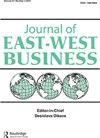汇款与金融发展之间的因果关系:来自金砖国家(巴西、俄罗斯、印度、中国和南非)的证据
IF 0.9
Q4 BUSINESS
引用次数: 6
摘要
摘要金融一体化带来的汇款稳定流动引起了学者和政策顾问的关注。尽管汇款的重要性越来越大,但对巴西、俄罗斯、印度、中国和南非汇款与金融发展之间关系的研究仍有待探索。因此,本文分析了汇款对金融发展的影响。它还利用巴西、俄罗斯、印度、中国和南非1990年至2019年的年度数据调查了汇款与金融发展之间的长期和短期关系。使用了三种不同的金融发展指标:私营部门的国内信贷占国内生产总值的百分比,银行存款占国内生产产值的百分比,流动负债占国内生产总额的百分比。本研究采用固定和随机效应模型、Johansen协整检验、向量误差校正模型和Wald检验进行分析。研究结果表明,汇款对银行存款产生了积极影响。它表明,汇款增加1%会导致银行存款增加4.5%。该研究还揭示了汇款和银行存款之间的长期关系,以及汇款和金融发展之间不存在短期关系。这项研究的主要影响可以预测,因为从长远来看,汇款可以积累储蓄,并为没有银行账户的收款人提供利用某些金融产品和服务的平台。没有短期关系表明汇款在短期内主要用于消费。然而,可以建议金砖国家经济体尽一切努力,通过降低汇款导向投资的交易成本和税收优惠,或通过对侨民具有竞争力的存款利率的银行对银行存款,增加汇款流入。本文章由计算机程序翻译,如有差异,请以英文原文为准。
Causal Linkage between Remittances and Financial Development: Evidence from the BRICS (Brazil, Russia, India, China, and South Africa)
Abstract The steady flow of remittances due to financial integration has grabbed the attention of academicians and policy advisors. Despite the growing importance of remittances, the study on the relationship between remittances and financial development in Brazil, Russia, India, China, and South Africa remains unexplored. Thus, this paper analyses the effect of remittances on financial development. It also investigates the long-run and short-run relationship between remittances and financial development using annual data of Brazil, Russia, India, China, and South Africa from 1990 to 2019. Three different financial development indicators are used: domestic credit to the private sector as a percentage of GDP, bank deposit as a percentage of GDP, liquid liabilities as a percentage of GDP. The study employs the fixed and random effect model, Johansen Cointegration tests, vector error correction model, and Wald tests for analysis. The results suggest a positive effect of remittances on bank deposits. It indicates that a 1% increase in remittances leads to a 4.5% increase in bank deposits. The study also reveals the long-run relationship between remittances and bank deposits and the absence of a short-run relationship between remittances and financial development. The main implications of the study can be predicted as remittances allow the accumulation of savings in the long run and provide the platform for the unbanked recipients to utilize certain financial products and services. The absence of a short-run relationship indicates that remittances are utilized mainly for consumption in the short run. However, it can be recommended that BRICS economies should make every effort to increase the remittance inflows through reduced transaction costs and tax benefits in remittance-led investment or banks to bank deposits with competitive deposit rates for the diaspora.
求助全文
通过发布文献求助,成功后即可免费获取论文全文。
去求助
来源期刊

Journal of East-West Business
BUSINESS-
CiteScore
2.10
自引率
26.70%
发文量
19
期刊介绍:
Journal of East-West Business is a quarterly journal that deals with contemporary and emerging aspects of business studies, strategies, development, and practice as they relate to the Russian Federation, the new republics of the Commonwealth of Independent States, and Eastern/Central Europe-and business relationships with other countries of the world. The Journal of East-West Business is international in scope and treats business issues from comparative, cross-cultural, and cross-national perspectives. The journal features an Editorial Advisory Board that represents the Russian Federation, Eastern/Central European, and Baltic states in this new business arena.
 求助内容:
求助内容: 应助结果提醒方式:
应助结果提醒方式:


